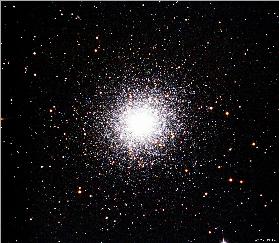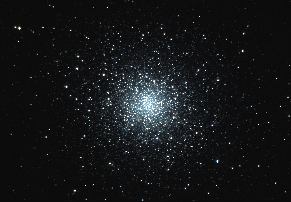Hercules
M13 - Hercules Cluster
M92 - Globular Cluster
In May, June and July the constellation Hercules comes almost overhead for those in the northern hemisphere. It lies roughly half way between the two bright stars Vega, in Lyra, and Arcturus, in Bootes. During those same months it can be seen just above the northern horizon from the southern hemisphere, but its low elevation may make the two A-List objects, M 13 and particularly M92, difficult to observe from the southern hemisphere. (At Sydney, M92 rises 12 degrees above the horizon, M13 rises 20 degrees above.)
M13 - The Hercules Cluster Globular Cluster E B L
This is arguably the finest globular cluster in the northern sky and was discovered by Edmund Halley in 1714. Charles Messier logged it as he tracked the path of a comet in 1779. However with a visual magnitude of 5.8 (the noted observer, James O'Meara puts it at 5.3) it is visible to the unaided eye so may well have been seen in antiquity. M13 lies along the western side of the "keystone" about 2.5 degrees south of the star Eta (?) Herculis. It is thus very easy to find. M13 contains several hundred thousand stars in a volume of space 145 light years across. It has an angular diameter of 20 arc minutes and lies around 25,000 light years from us. These statistics hide the sheer beauty of the cluster which needs a really dark and transparent sky and good seeing to observe at its best. (These do not often occur together!) The dark sky enables fainter stars to be seen and, if the atmosphere is steady, the stellar images will be “tighter” allowing even fainter stars to stand out against the background glow of light from the cluster. It will look good in any telescope, however small, but the view through a 10 inch (250mm) or larger telescope under perfect conditions can take your breath away, with M13 looking almost three dimensional in appearance. Curving arcs of stars appear to extend southeast and northwest branching out into the surrounding space. Several stars reach 11th and 12th magnitudes with 20 or more at 13th magnitude.
Position: 16h 41.7m +43deg 08min
M92 Globular Cluster B M
M92 is also a superb globular cluster, somewhat overshadowed by its near neighbour M13. With a visual magnitude of 6.5, it is just on the limit of unaided eye visibility but really needs binoculars or a telescope to observe. M92 is north and a little east of the north-eastern star of the keystone, third magnitude Pi Herculis. With an equatorially mounted telescope, centre the finder or low power field of view on this star and then move very slightly northeast to the 5th magnitude star 69 Herculis. Lock the right ascension axis then sweep north in declination just under 6 degrees. M92 will then be in the centre of the field. It lies at a distance of about 27,000 light years and has an angular extent of 14 arc minutes corresponding to a diameter of 109 light years. The total mass of the stars is of order 300,000 solar masses. At a very similar distance from us as M13, some of the brightest stars within it will be individually resolved with good seeing and transparent skies. Remember that fainter stars can be seen when “averted vision” is used - just look slightly away from the centre of the cluster.
Position 17h 17.1m +43deg 08min





